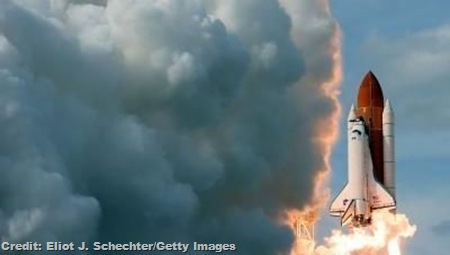
10 Offbeat Things Humans Have Launched Into Space
By Laurie L. Dove, How Stuff Works, 21 October 2012.
By Laurie L. Dove, How Stuff Works, 21 October 2012.
From a lead cargo tag uncovered by archaeologists in Jamestown, Virginia [USA], to unauthorized postage stamps astronauts intended to sell, members of the space program have been inventive about what they take into space.
Space Shuttle Discovery blasts off from the Kennedy Space Centre on April 5, 2010, in Cape
Canaveral, Florida. See more space exploration pictures. Photo: Joe Raedle/Getty Images.
In between the final launch of the NASA space shuttle Atlantis in July 2011 and its first space flight 30 years earlier, there were more than 100 journeys - and just about as many unusual items on board.
Wondering what other offbeat items humans have launched into space? Whether it's a paper airplane or a stuffed animal added to a space shuttle's manifesto, or even a DIY project that sent a child's toy into near-orbit, there have been plenty of upward-bound items that were far from necessary cargo. If you think these examples were odd, we're sure you'll want to know why the cells of a long-dead woman were on-board or why glow-in-the-dark beads tagged along for a ride.
10. Buzz Lightyear
Buzz Lightyear action figure toy (Source)
"To infinity ... and beyond!" may have been Buzz Lightyear's fictional call-to-action, but in 2008 the catchphrase signalled a literal adventure for this Disney character. That's when a 12-inch (30.5-centimetre) Buzz Lightyear action figure orbited the Earth for 468 days as a passenger aboard the International Space Station. Lightyear was part of an educational outreach program during Space Shuttle Discovery's STS-124 mission to the space station. Lightyear was a featured character in the STEM program, which stands for Science, Technology, Engineering and Mathematics; it included a series of online learning games and science lessons piped into elementary school classrooms [source: Pearlman].
When he did finally come back to Earth, Lightyear, a character in Disney-Pixar's 1995 animated "Toy Story" film, returned to a hero's welcome - one that included his eventual instalment in the Smithsonian Museum's National Collection. Despite a spate of media attention, Lightyear remains mum on whether he prefers the travel of a space shuttle to a self-powered backpack rocket [source: Siceloff].
Where No Lego Has Gone Before
Ever heard of Canada's space program? Neither had two Canadian teenagers who decided to take matters into their own hands. In January 2012, Mathew Ho and Asad Muhammad placed a Canada flag in the hand of a Lego action figure, attached the Lego man to a hand-stitched parachute and then affixed the entire contraption to a weather balloon. When released, the Lego man travelled 80,000 feet (15.15 miles, or 24.38 kilometres) in the air - high enough to see the curvature of the Earth - and on-board cameras captured stunning video of its journey [source: Malik].
|
9. HeLa Cells
A fluorescence micrograph of HeLa cells (Source)
HeLa cells are named for Henrietta Lacks, a 1950s cancer patient from whom they were sampled. Lacks later succumbed to the cervical cancer that had spread throughout her body, but the descendants of the hardy cells that were removed from her body are still alive today. In the 1960s, they were rocketed into space with the second Russian satellite ever put into orbit. HeLa cells also were sent with the first humans to go into space, where scientists discovered HeLa cells divided even more quickly in zero gravity. Today, HeLa cells are at the heart of much scientific research. They've been instrumental to researchers developing vaccines and HIV tests, studying disease processes and mapping genetic code [source: NPR].
Henrietta Lack's cells are popular among researchers because, unlike normal human tissue, they divide indefinitely in a laboratory setting and are stable enough to survive shipping. Although controversy has surrounded HeLa cells (Lacks never consented to their removal, nor did her family know of her scientific legacy for several years), Lacks' line of cells did something few people ever do, alive or dead: Orbit the Earth and, arguably, impact medicine around the world [source: Zielinski].
8. Luke Skywalker's Lightsaber
The lightsaber prop used by Luke Skywalker in Return of the Jedi spent two weeks on Space
Shuttle Discovery (Source)
No well-dressed Star Wars devotee (or costume-enthusiast, for that matter) would dare to be seen without the series' most recognizable weapon: a lightsaber. Turns out, neither would the Space Shuttle Discovery.
In 2007, the Discovery travelled into deep space with an assortment of artefacts reflecting earthly accomplishments, including a plastic movie prop once wielded by actor Mark Hamill, who played Luke Skywalker in "Return of the Jedi." The lightsaber handle embarked on its storied journey some three decades after the original Star Wars trilogy was released. At the end of its 14-day trip, Skywalker's lightsaber was returned to moviemaker George Lucas, the creator of Star Wars.
Some icons, however, have a long shelf life in space, where they remain plastered to the International Space Station walls. Among the more memorable items are a golf ball, a family portrait and a series of digitally encoded signatures [source: Siceloff].
Soviet Firearms
Russian astronauts have long been carrying real weapons into space, and not just because they expect to encounter alien young-guns. Firearms are routinely packed among orbiting goods in case a space capsule veers off course during re-entry. In 1965, newly landed astronauts found themselves stranded in the Ural Mountains and attempted to keep wolves at bay without the benefit of firepower; Russian astronauts have been armed ever since [source: Garmon]
|
7. Communion Wine
Astronaut Buzz Aldrin on the moon (Source)
When humans first landed on the moon in July 1969, there was another "first" that took place, too. Astronaut Buzz Aldrin poured a vial of communion wine, set out communion bread, then asked the mission's ground crew for a few moments of radio silence as he ingested the communion elements. While the line-up wasn't exactly a standard astronaut MRE, Aldrin later revealed the ritual was meant to commemorate the discovery of a new world just as Christopher Columbus and other explorers were believed to have done: by celebrating communion.
Although rumours circulated for years that Aldrin's act of communion was suppressed by the government, his plan to break bread on the moon was anything but secret. Not only did the ground crew know, but so did his Presbyterian congregation in Houston, Texas; in the decades that followed, Aldrin shared his story of communion on the moon in magazine articles and included it in his book, "Magnificent Desolation," which was released in 2009 [source: Mikkelson].
Space Station Hooch
The International Space Station is home to a host of experiments studying the effects of zero gravity on various items, including alcohol. By 2013, the results of a partnership with a Scottish whisky distillery could reveal whether alcohol brewed in space tastes better than its earthbound counterpart. No word on whether a space bar franchise is in the works [source: Wilkins].
|
6. Dirt from Yankee Stadium
Astronaut Garrett Reisman (Source)
We imagine there's a lot of stuff floating around in space, like the odd malfunctioning satellite and the occasional space-dust bunny. But now we can add one more thing to the list: dirt from Yankee Stadium. Thanks to astronaut Garrett Reisman, who also happened to be a Yankee devotee, dirt from the famed New York City pitcher's mound was aboard space shuttle Endeavour's 2008 STS-123 mission.
From his post on the International Space Station, Reisman even managed to throw out the first pitch on April 16, 2008, to open the Yankees versus Red Sox game (via satellite broadcast, of course). It was a fitting legacy for a space explorer who insisted on taking baseball mementos bearing the signature of New York Yankees' owner (1973-2010) George Steinbrenner along for a shuttle ride. And a fitting legacy for America's pastime, too, especially if there is life on other planets. Just imagine: Major League Baseball could someday include interstellar playoffs [source: Hoch].
Shea Stadium's Home Plate
|
5. A Space Spatula
Space Spatula (Source)
When we first got wind of a spatula circling the third rock from the sun every 90 minutes or so, the only thing that seemed stranger was the fact that military radar stations were tracking it throughout the world. Or maybe the fact that it was ever launched into space in the first place.
Although visions of astronauts competing in burger-flipping wars danced in our heads, the truth was a bit more mundane. The spatula was one of five used to make repairs during a spacewalk by astronaut Piers Sellers in 2006. During a voyage on the Discovery shuttle, he used the spatula to smooth protective liquid onto the shuttle's heat shield, but eventually lost the tool when it became unleashed and drifted into space. It was tracked across the globe to ensure it didn't pose a collision risk to existing objects in orbit - including, at the time, the space shuttle [source: Malik].
4. Last Remains
Actor James Doohan (Source)
If you or a loved one has ever dreamed of traveling into space, but just couldn't quite manage to do it within your lifetime, there's still hope. For a fee, a sampling of a person's cremated remains can be launched into space aboard a rocket, bringing the dream of space flight full circle. Concerned about becoming free-roaming space debris? In most cases, a person's ashes are integrated into a rocket-propelled satellite set to orbit the Earth for weeks or years - however long it takes before the craft re-enters the Earth's atmosphere, where the satellite and its ashen cargo will be decimated by fire.
The first-ever private launch of last remains into outer space took place in 1997, and carried the ashes of two dozen participants, including "Star Trek" creator Gene Roddenberry and 1960s LSD enthusiast Timothy Leary [source: Celestis]. Since then, hundreds more have made the celestial leap, including James Doohan, the late actor who played Scotty on the long-running "Star Trek" series [source: Allen].
3. Golf Clubs
Alan B. Shepard holding the moon club (Source)
Golf has been a part of space exploration from the very beginning. Alan Shepard was the first American in space in 1961, but it was in 1971 when he used a specially made 6-iron to hit a golf ball on the surface of the moon. Sure, Alan Shepard, a member of the famous Apollo 14 mission, went down in history for more than hitting a golf ball 200 yards (182.9 meters) in zero-gravity, but his idea launched a legacy [source: Driscoll].
Sending a golf ball (or anything, actually) hurtling into space isn't always such sporting fun, although the outcome may be. As early as 1976, composite materials initially tested in the space shuttle program were used to make golf clubs that had just the right balance of strength and flexibility, leading to a new era of power swings [source: NASA]. As for the makeshift club that started it all? Shepard gave the storied club to the Arnold Palmer Centre for Golf History at the USGA Museum in Far Hills, New Jersey [USA].
Space Flight is for Kids, Too
Inspired by the story of two teenagers who sent a Lego man into space, a California father and 4-year-old son filmed a toy train's 18-mile (28.97-kilometre) high launch (and rapid descent) in 2012. The train landed, unhurt, in a field about 27 miles (43.45 kilometres) from its launch site, much to the boy's relief. Although the journey itself was remarkable, the animated video Ron Fugelseth created with the footage has been viewed more than 3 million times - and that's remarkable, too [source: Associated Press].
|
2. Holy Relics
Examples of souvenirs on-board shuttle Discovery (Source)
In 2012, the first commercial craft launched by the U.S. headed for the International Space Station. Although this unmanned spacecraft carried necessities, such as food and storage bags, it also travelled with more than 12,000 souvenirs bound for the stars and back. Presumably to be offered as mementos to those involved in the project, the patches and medallions weren't meant to stay at the International Space Station [source: Collect Space]. But that's not always the case.
The International Space Station is a final resting place for dozens of personal artefacts deposited by astronauts, including religious relics. Russian cosmonauts, for example, have transported religious tomes, icons and crosses - including one believed to contain a piece of the wooden cross on which Jesus was crucified - to the space station. Astronauts from the U.S. have contributed, too, leaving behind several relics of saints [source: Catholic News Agency].
1. Beads of Courage
Examples of "Beads of Courage" designs on space shuttle Atlantis (Source)
Arizona oncology nurse Jean Baruch had mastered the technical aspects of her job, but felt she could do more to provide the emotional care children with cancer required. And when she noticed how much children with serious illnesses loved crafts projects during summer camp, especially those involving beads, she leapt into action.
Baruch founded Beads of Courage to take the joys of beading into a paediatric hospital setting, using the beads to symbolize a child's spirit, strength and patience during the many medical procedures they often endure. Although the concept grew from one hospital in 2004 to more than 60 hospitals around the world, even Baruch probably never dreamed these special beads would travel to outer space [source: Bannan]. However, when a NASA contractor whose daughter was battling cancer requested the beads accompany astronauts in the space shuttle Atlantis in May 2010, that's exactly what they did [source: Roy].
The beads' journey symbolized not only the strength and resilience of children, but the powerful human element at the heart of space exploration.
Sources:
1. Allen, Nick. "Scotty from Star Trek's Ashes to be Blasted Into Space." The Telegraph. May 21, 2012. (Oct. 7, 2012)2. Associated Press. "Aptos Dad Finds 15 Minutes of YouTube Fame with Launch of Son's Toy Train." The Oakland Tribune. Sept. 24, 2012. (Oct. 7, 2012)
3. Bannan, Karen. "Beads of Hope." Ladies' Home Journal. (Oct. 8, 2012)
4. Catholic News Agency. "Relics, Icons and Crosses are On-board International Space Station, Cosmonaut Says." Jan. 20, 2010. (Oct. 8, 2012)
5. Celestis. "About Celestis." (Oct. 7, 2012)
6. Collect Space. "The Not-So-Secret Souvenirs Riding Historic SpaceX Capsule Flight to Space Station." May 18, 2012. (Oct. 8, 2012)
7. Driscoll, Ron. "Museum Moment: Mission Accomplished: Shepard's 'Moon Club' Brought Golf to Lofty Heights." USGA Museum. Feb. 3, 2011. (Oct. 8, 2012)
8. Garmon, Jay. "Geek Trivia: Fire (arms) in the Sky." Tech Republic. March 27, 2007. (Oct. 7, 2012)
9. Hoch, Bryan. "Astronaut Makes First-Pitch History." Major League Baseball. April 16, 2008. (Oct. 7, 2012)
10. Malik, Shiv. "Canadian Teenagers Send Lego Man into Space." The Guardian. Jan. 26, 2012. (Oct. 6, 2012)
11. Malik, Tariq. "Spacewalkers Test Shuttle Heat Shield Repair Technique." Space. July 12, 2006. (Oct. 7, 2012)
12. Mikkelson, Barbara. "Communion on the Moon." Snopes.com. March 25, 2012. (Oct. 6, 2012)
13. NASA. "Composite Golf Clubs." 1976. (Oct. 7, 2012)
14. NPR. "'Henrietta Lacks': A Donor's Immortal Legacy." Feb. 2, 2010. (Oct. 6, 2012)
15. Pearlman, Robert. "Buzz Lightyear Becomes Real Space Ranger." Space. May 29, 2009. (Oct. 6, 2012)
16. Potter, Ned. "It's Outta Here: Astronaut Takes Mets' Home Plate in Shuttle Atlantis." ABC News. July 31, 2009. (Oct. 7, 2012)
17. Roy, Steve. "Bonds of Courage, Beads of Courage Fly on Atlantis, STS-132." NASA. (Oct. 7, 2012)
18. Siceloff, Steven. "Buzz Lightyear to Soar with Discovery." NASA. May 29,2008. May 10, 2010. (Oct. 6, 2012)
19. Siceloff, Steven. "Items Taken into Space Reflect Accomplishments on Earth." NASA. Oct. 24, 2007. (Oct. 6, 2012)
20. Wilkins, Alasdair. "The International Space Station is Ready to Make its Own Booze." Io9.com. April 10, 2012. (Oct. 7, 2012)
21. Zielinski, Sarah. "Henrietta Lacks' 'Immortal' Cells." Smithsonian. Jan. 22, 2010. (Oct. 6, 2012)
Top image: Space Shuttle
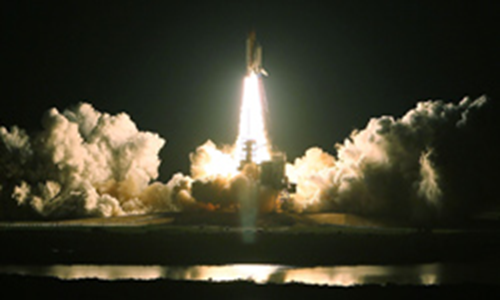
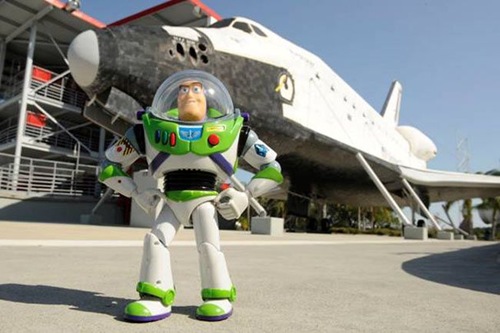
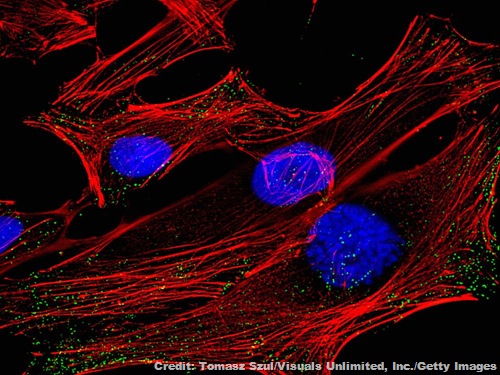

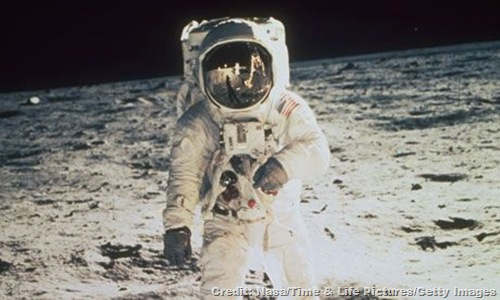


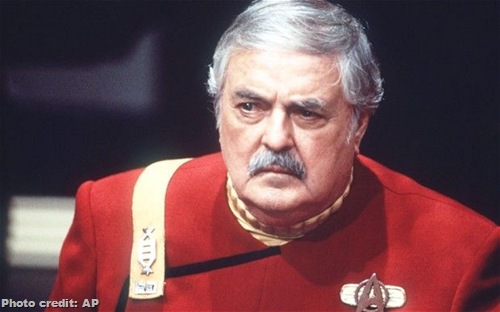
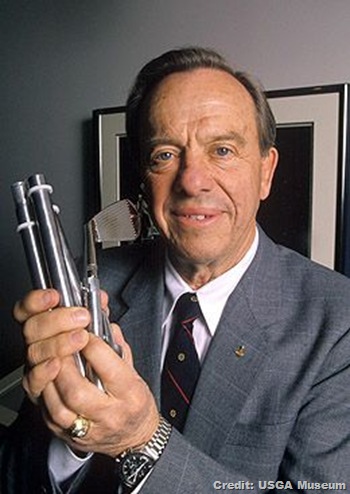
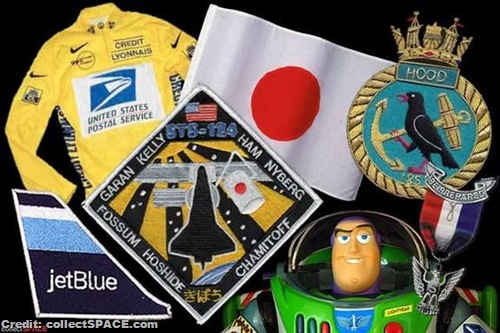


No comments:
Post a Comment
Please adhere to proper blog etiquette when posting your comments. This blog owner will exercise his absolution discretion in allowing or rejecting any comments that are deemed seditious, defamatory, libelous, racist, vulgar, insulting, and other remarks that exhibit similar characteristics. If you insist on using anonymous comments, please write your name or other IDs at the end of your message.